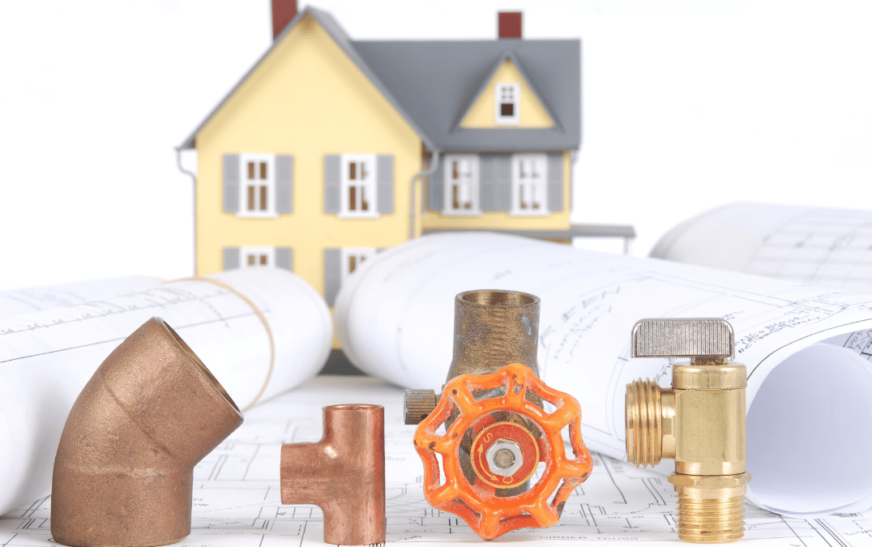Copper plumbing has been used in homes for over 80 years and is still one of the top choices for residential plumbing systems. Its durability, resistance to corrosion, and ability to handle high water pressure make it a popular material among homeowners and plumbers.
But have you ever wondered how long this trusty piping can last before needing replacement? The timeline is 50 to 70 years, so we should be aware of factors that may affect its lifespan.
I will dive into the research behind copper plumbing’s longevity and provide tips on extending its lifespan. So buckle up as we uncover how long copper plumbing can last in our homes.
How Long Can You Expect Copper Plumbing to Last?
Copper plumbing is renowned for its durability and longevity, with an expected lifespan typically ranging between 50 to 70 years under ideal conditions. Its resilience against corrosion, high temperatures, and pressure makes it a popular choice for residential and commercial plumbing systems.
Copper resists rust and decay, contributing to their extended service life. However, the actual lifespan can be influenced by water quality, soil conditions, and the presence of acidic or alkaline substances, which can affect the pipes over time. Regular inspections and timely repairs can address any issues early and ensure the plumbing system remains in good condition for decades.
Factors That Influence the Durability of Copper Plumbing
The lifespan of copper pipes can vary significantly based on several factors. Understanding these factors can help in making informed decisions about installation, maintenance, and material selection. Several factors can influence the durability of copper plumbing:
Water Quality:
The quality of water flowing through copper pipes can significantly affect their lifespan. Water with high acidity (low pH) or high mineral content (hard water) can accelerate corrosion, reducing lifespan. In such cases, treating the water or choosing a different type of piping material may be necessary to prevent premature failure.
Water Temperature:
Elevated water temperatures can expedite the process of corrosion within plumbing systems. While copper pipes are known for their durability, they are susceptible to faster corrosion rates when exposed to water temperatures consistently surpassing 140°F (60°C). This highlights the importance of maintaining appropriate water temperature levels to prolong the longevity of copper pipes in residential or commercial settings.
Water Velocity:
High water velocity can lead to erosion-corrosion, a process that gradually wears down the copper material over time due to the force and speed of the water flow. By ensuring that pipes and fittings are appropriately sized to match the water system’s demands, the risk of erosion-corrosion can be effectively reduced, thus prolonging the longevity of the copper components in the infrastructure.
Oxygen Exposure:
Copper pipes are susceptible to accelerated corrosion when they come into contact with elevated oxygen levels. This issue is particularly problematic in systems with air and water, as it expedites the corrosion process, potentially leading to structural damage and leaks over time.
Installation Quality:
Proper installation is key to ensuring the longevity of copper pipes. Poor installation practices, such as improper soldering, incorrect pipe sizing, or inadequate support, can lead to leaks, corrosion, and premature failure. An often overlooked aspect of this process is accurate planning and budgeting, which can be achieved through plumbing estimating services. These services help ensure that the correct materials are selected, appropriate pipe sizes are used, and all necessary fittings and supports are accounted for.
Chemical Exposure:
Exposure to certain chemicals, such as chlorine or acidic cleaning agents, can accelerate corrosion. Ensure that the water treatment and cleaning agents used are compatible with copper.
By addressing these factors, you can extend the lifespan of copper plumbing systems and maintain their durability.
Different Copper Piping Types and Their Lifespans
Copper piping is widely used in plumbing due to its resilience, flexibility, and corrosion resistance. Here is a comprehensive look at the various types of copper piping:
Type K Copper Pipe
Type K pipes are known for their exceptionally long lifespan, often 100 years or more when properly installed and maintained. This makes them an excellent choice for applications where longevity is crucial.
Usage:
Due to its durability, Type K copper pipe is primarily used for underground and main water supply lines. It is also commonly used in HVAC (heating, ventilation, and air conditioning) and fire protection systems. The thick walls of Type K piping can withstand high pressures and harsh environmental conditions, such as corrosive soil.
Type L Copper Pipe
Type L pipes typically have a lifespan of 50 to 100 years, but this can vary depending on the installation environment, water quality, and maintenance practices.
Usage:
Type L copper pipes are widely used in residential and commercial plumbing systems. They are suitable for interior water supply lines, including hot and cold water distribution. Additionally, they are often used in underground applications, though they are not as robust as Type K in such environments.
Type M Copper Pipe
The lifespan of Type M copper pipes is generally 20 to 50 years. However, factors such as water quality and installation practices can significantly impact their longevity.
Usage:
Type M copper pipes are typically used in residential plumbing where the water pressure is lower, and the pipes are less likely to experience external damage. They are most commonly used in interior water distribution systems, particularly in budget-conscious projects.
DWV Copper Pipe (Drain, Waste, and Vent)
The lifespan of DWV copper pipes ranges from 20 to 50 years, depending on the conditions of use. Since these pipes are not used for water distribution, factors like water quality do not impact their longevity.
Usage:
DWV copper pipes are designed for drainage, waste, and vent systems. They are not suitable for water supply lines because they cannot withstand the pressure associated with such applications. Instead, they carry wastewater and vent sewer gases safely out of buildings.
By understanding the differences in copper piping types and their lifespans, homeowners and contractors can make informed decisions that ensure the long-term reliability and efficiency of their plumbing systems.
Copper vs. Other Plumbing Materials: Which Lasts Longer?
Copper plumbing is renowned for its longevity and durability, typically lasting between 50 and 70 years under optimal conditions. Its resistance to corrosion and high temperatures make it a preferred choice for many homeowners. However, other materials also have notable characteristics.
PEX (cross-linked polyethylene) is known for its flexibility, resistance to scale, and ease of installation. It has a comparable lifespan of 40 to 50 years, though it may be more vulnerable to UV damage if exposed.
PVC (polyvinyl chloride) pipes are cost-effective and resistant to corrosion. However, they typically last 25 to 40 years and can be damaged by extreme temperatures and physical impacts.
Cast iron, while durable and resistant to fire, has a shorter lifespan of 30 to 50 years and can be prone to rust and deterioration over time. Each material has advantages and limitations, but copper remains a strong contender for its proven longevity and reliability, provided it is properly maintained and protected from environmental factors.
Should You Repair or Replace A Copper Plumbing Line?
Deciding whether to repair or replace a copper plumbing line depends on several factors, including the age of the piping, the extent of the damage, and the overall condition of the plumbing system. If the copper pipes are relatively new and the damage is localized, such as a small leak or minor corrosion, a repair might be sufficient and cost-effective.
However, replacement might be the better long-term solution if the pipes are old, have widespread corrosion, or have developed multiple leaks. Replacing aging copper pipes can prevent future problems, improve water quality, and ensure the plumbing system remains reliable. Additionally, if the plumbing issues are frequent, a replacement could save money and hassle in the long run. Always consider the condition of the entire plumbing system and consult a professional plumber to determine the most appropriate course of action.
Conclusion
Copper plumbing has been a reliable and durable option for homes for over 80 years. Through advancements in technology and the implementation of proper maintenance, this material has proven to stand the test of time. While the lifespan of copper plumbing ultimately depends on various factors, such as water quality and usage, it can last up to several decades with proper care. Investing in quality materials and hiring experienced professionals for installation and repairs can greatly extend the lifespan of copper plumbing in your home. However, it is important to note that just like any other house component, copper plumbing may eventually need to be replaced. So whether you are building a new home or updating an older one, consider the longevity and reliability of copper plumbing to ensure a happy and functional household for many years to come.
Feel free to submit more guest posts through Links Building Servcies - Best Prices. Buy Author Account / 1$ Guest Post Here
























